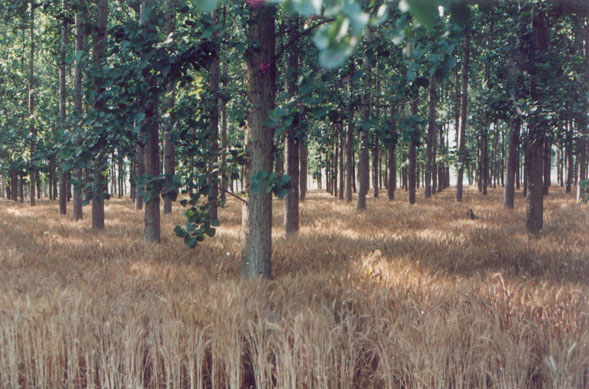 Agroforestry is an area wherein Haryana State has taken long strides. This is the only way in which the State can increase its area under green cover. The Forest Department has been distributing 2.5 crore seedlings every year to the farmers and other tree growers free of cost to promote agroforestry. Recently, the department has decided to sell the seedlings on subsidised cost. Agro-forestry has enabled the forest deficient state of Haryana to support a large number of wood-based industries based on farm-grown wood. The town of Yamuna Nagar has virtually become the national center of plywood and veneer industry. Our policy of not having any restrictions on the felling of trees from private areas and on the transit of wood has also helped in expanding the timber trade and wood-based industries. Our endeavor is to create favorable conditions so that wood-based industries and agroforestry activity can further grow simultaneously.
Agroforestry is an area wherein Haryana State has taken long strides. This is the only way in which the State can increase its area under green cover. The Forest Department has been distributing 2.5 crore seedlings every year to the farmers and other tree growers free of cost to promote agroforestry. Recently, the department has decided to sell the seedlings on subsidised cost. Agro-forestry has enabled the forest deficient state of Haryana to support a large number of wood-based industries based on farm-grown wood. The town of Yamuna Nagar has virtually become the national center of plywood and veneer industry. Our policy of not having any restrictions on the felling of trees from private areas and on the transit of wood has also helped in expanding the timber trade and wood-based industries. Our endeavor is to create favorable conditions so that wood-based industries and agroforestry activity can further grow simultaneously.
Although, the national goal is to bring at least one-third of the country’s geographical area under forest and tree cover by the year 2012, our vision is to bring forest and tree cover over at least 20 percent of the State’s geographical area in a phased manner. Our endeavour is to involve rural people, especially women, in raising forest nurseries so that agroforestry can become a people’s movement. The state is also establishing organized timber market (Mandis) at the Yamunanagar district of the state to facilitate transparent trade of farm-grown wood.
Agroforestry is the most economical, sustainable and stable alternative for ecological security of the land production system. Whereas the average productivity of plantations in forest and wastelands is approximately 4 to 5 cubic meters per hectare per year, seed-route agroforestry plantations in irrigated land ensure average productivity of 10 to 15 cubic meters per hectare. The average productivity has been enhanced to 25 to 30 cubic meters per hectare per year from poplar and clonal eucalyptus plantations. Thus, by all aspects, agroforestry is a cheap, profitable and sustainable alternative. However, there are still problems associated with species suitability, marketing, policy, and industrialization for which there is a great necessity for discussion and deliberation.
There is a vast scope of Research and Development (R&D) in the field of agro-forestry. Many high-yielding clones of agroforestry species have been evolved which need to be demonstrated in the field, so that tree growers can increase productivity of their plantations. High yielding and disease resistant clones of eucalyptus, poplar, teak, ailanthus, khejri, etc. need to be evolved through continuous research
The assistance is required from the Central Government in R&D and extension activities. Plantations of poplar were instrumental in the expansion of the plywood and veneer industry in Haryana State. Further research need to be conducted for developing alternative uses of poplar wood to expand its marketability.
There have been many fluctuations in the prices of eucalyptus and poplar wood due to variations in demand and supply which always poses a threat that farmers may become indifferent to agro-forestry. This issue should be taken up with more seriousness and priority and there is an urgent need to work on issues related to marketing and government policies of import and export of wood.

